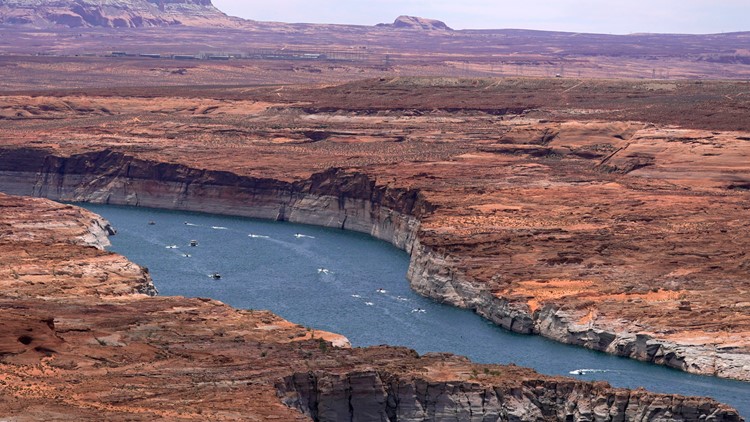SACRAMENTO, Calif. — Federal officials said Wednesday that conditions have improved on the Colorado River to the point that a plan by California, Arizona and Nevada to voluntarily reduce water use should help keep the river basin on stable footing for the next few years.
The U.S. Department of the Interior said in a statement that the risk of reaching critically low water elevations at Lake Powell and Lake Mead, the river's two key reservoirs, has gone down substantially.
“We have staved off the immediate possibility of the System’s reservoirs from falling to critically low elevations that would threaten water deliveries and power production,” Deputy Secretary Tommy Beaudreau said in a statement.
The river serves seven U.S. states, Native American tribes and two states in Mexico, supports a multibillion-dollar farm industry in the West and generates hydropower used across the region. Years of overuse by farms and cities and the effects of drought worsened by climate change has meant much less water flows through the river today than in previous decades.
But the announcement displays how much things have changed since summer 2022, when U.S. Bureau of Reclamation Commissioner Camille Touton said drastic cuts would be needed to stave off a crisis in the river. The states failed to reach a consensus on cuts, and the federal government did not end up forcing any.
Earlier this year, the Biden administration released two options that would have forced cuts on Arizona, California and Nevada either proportionally or based on the existing water priority system, which most benefits California. The threat of those two options finally forced the three states to reach their own voluntary plan for how to reduce their use of the river's water.
In May, they proposed to help shore up water levels by conserving at least an additional 3 million acre feet of water through the end of 2026 in exchange for $1.2 billion in federal money.
Though the federal government needs to finish its regulatory process, Wednesday's announcement indicates it is poised to officially accept that plan, said JB Hamby, chairman of the Colorado River Board of California and a board member at the Imperial Irrigation District, the largest user of the river’s water.
Federal money and a good winter that shored up water supplies across California and the West have helped changed the trajectory of negotiations, he said.
“This is a victory for collaboration as an approach rather than conflict, which is where we started,” Hamby said.
California will be responsible for more than half of the total cuts. Those could be achieved through things like implementing water efficiency measures and idling certain crops for months at a time, Hamby said previously.
Already, the three states have lowered their water use, said Tom Buschatzke, director of the Arizona Department of Water Resources and the state’s representative on Colorado River issues. He said Arizona was on track this year to use about one-third less water than the amount it is allocated.
“Arizona’s conservation efforts alone have been substantial,” he said in a statement.
Now, the states can turn their attention to a new long-term agreement for how to share the river’s water beyond 2026.
Hamby said he looks forward to “using that momentum to start to build what the next 20 years looks like on the Colorado River.”
__
Taxin reported from Santa Ana, California. Associated Press writers Suman Naishadham in Washington and Ken Ritter in Las Vegas contributed.
Water Wars
Catch up on the latest news and stories surrounding Arizona’s water crisis on the 12News YouTube channel. Subscribe today.



